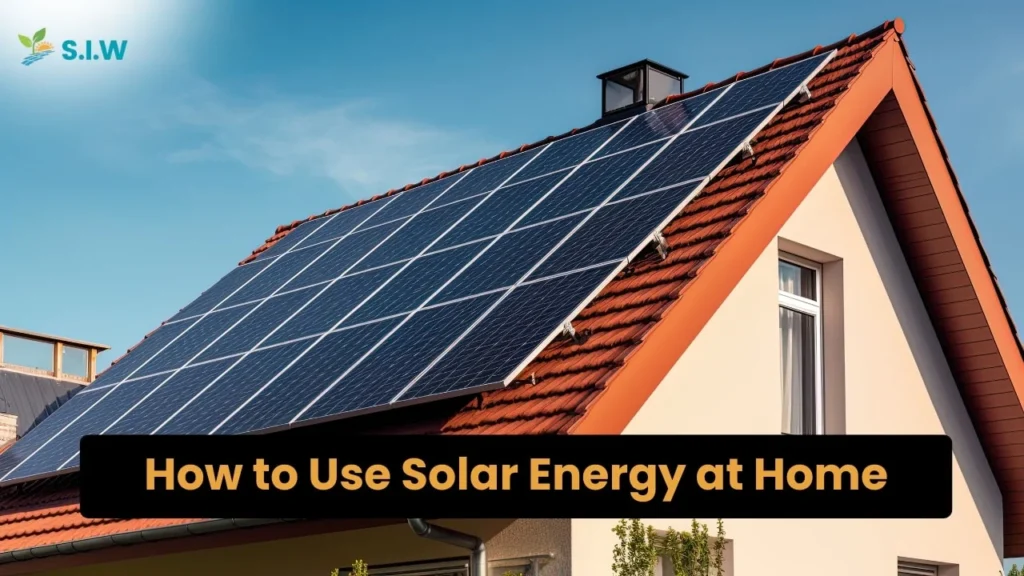Using solar energy at home is a smart and sustainable choice. Solar energy harnesses sunlight and converts it into electricity, reducing reliance on fossil fuels and lowering energy bills. But how does it work? Let’s break it down in a way that’s easy to understand!
First, solar panels capture sunlight using photovoltaic (PV) cells. When sunlight hits these cells, they generate direct current (DC) electricity. An inverter then converts this DC electricity into alternating current (AC) electricity, which is used to power your home appliances.
Many homeowners are making the switch to solar energy. A study by the National Renewable Energy Laboratory (NREL) shows that solar energy can cover a significant portion of household energy needs, especially in sunny regions.
Benefits of Using Solar Energy
One of the biggest advantages of solar energy is its environmental impact. By using solar panels, you’re contributing to a reduction in greenhouse gas emissions. This shift toward renewable energy helps combat climate change and creates a cleaner environment for future generations.
Additionally, solar energy can save you money. After the initial investment in solar panels and installation, many homeowners see a substantial reduction in their monthly electricity bills. Some states even offer incentives and rebates, making solar energy even more affordable.
Choosing the Right Solar System
When considering solar energy for your home, it’s essential to choose the right solar system. Factors to consider include the size of your roof, your energy needs, and your budget.
For instance, if you have limited roof space, you might consider Hoymiles Microinverter systems. Microinverters allow each solar panel to operate independently, maximizing energy production even in shaded areas. This technology is efficient and can boost your overall energy output.
Solar Panel Types
There are several types of solar panels available on the market. The most common are monocrystalline, polycrystalline, and thin-film solar panels.
Monocrystalline panels are known for their high efficiency and sleek appearance. They work well in limited space because they generate more energy per square foot compared to other types.
Polycrystalline panels are generally less expensive but have a lower efficiency rate. They are made from multiple silicon crystals and are often seen as a cost-effective option for larger installations.
Thin-film solar panels are lightweight and flexible, making them easy to install on various surfaces. However, they typically have lower efficiency rates and may require more space for installation.
Battery Storage Solutions
To maximize your solar energy use, consider integrating battery storage into your system. Panasonic Batteries are a popular choice among homeowners. These batteries store excess energy generated during the day for use at night or during cloudy days.
Having a battery storage system enhances your energy independence, allowing you to rely less on the grid. This is particularly beneficial during power outages, ensuring you have a backup energy source when you need it most.
Installation Process
Installing solar panels is a significant investment, but the process is straightforward. First, a solar provider will conduct a site assessment to evaluate your roof’s suitability for solar panels. This assessment includes analyzing your roof’s orientation, pitch, and shading.
Once the assessment is complete, the installation process can begin. Solar panels are typically mounted on the roof using brackets. The panels are connected to the inverter, which is usually installed in the garage or basement.
After installation, a local inspector will check the system to ensure it meets safety standards. Once approved, you can start enjoying the benefits of solar energy!
Solar Services and Maintenance
Once your solar energy system is up and running, regular maintenance is essential for optimal performance. Most solar panels require minimal upkeep, but it’s important to keep them clean and free of debris. Regular inspections by professional solar services can help identify any potential issues before they become costly repairs.
Additionally, many solar providers offer maintenance plans that include regular cleaning and monitoring of your system’s performance. This ensures you’re getting the most out of your investment.
Environmental Impact
Switching to solar energy not only benefits your wallet but also the planet. Solar power reduces your carbon footprint and contributes to a cleaner environment. According to the U.S. Department of Energy, solar energy is one of the most abundant and sustainable energy sources available today.
By using solar energy at home, you’re part of a larger movement toward renewable energy. This transition is crucial for reducing greenhouse gas emissions and combating climate change.
Real-Life Success Stories
Many homeowners have made the switch to solar energy and experienced remarkable benefits. For example, one family in California installed solar panels on their roof and saw their energy bills decrease by 70%. They also took advantage of state incentives, significantly lowering their initial investment.
Another homeowner shared how installing a solar system made her home more energy-efficient. With the help of Hoymiles Microinverter technology, her solar panels generated more energy than expected, allowing her to sell excess energy back to the grid.
Frequently Asked Questions
Q1: How much does it cost to install solar panels?
The cost of installing solar panels varies based on system size, location, and available incentives. On average, homeowners can expect to spend between $15,000 to $30,000 before tax credits and rebates.
Q2: How long do solar panels last?
Solar panels typically have a lifespan of 25 to 30 years. Many manufacturers offer warranties that guarantee performance for at least 25 years.
Q3: Can I install solar panels myself?
While it’s possible to install solar panels yourself, it’s often best to hire a professional. This ensures proper installation, compliance with local regulations, and maximizes system performance.
Q4: Will solar panels work in cloudy weather?
Yes, solar panels can still generate energy on cloudy days, although their efficiency may be reduced. Solar systems are designed to capture sunlight even in less-than-ideal conditions.
Q5: What incentives are available for solar installation?
Many states offer tax credits, rebates, and other incentives for solar installation. Check with your local government or solar provider for specific details.








